Development of a Web-Based L-THIA 2012 Direct Runoff and Pollutant Auto-Calibration Module Using a Genetic Algorithm
Abstract
:1. Introduction
2. Materials and Methods
2.1. Overview of the L-THIA

| GA control variables | Values |
|---|---|
| Population size | 100 |
| Number of generation | 500 |
| Number of significant digits | 5 |
| Crossover probability | 0.85 |
| Initial mutation rate | 0.005 |
| Minimum mutation rate | 0.0005 |
| Maximum mutation rate | 0.25 |
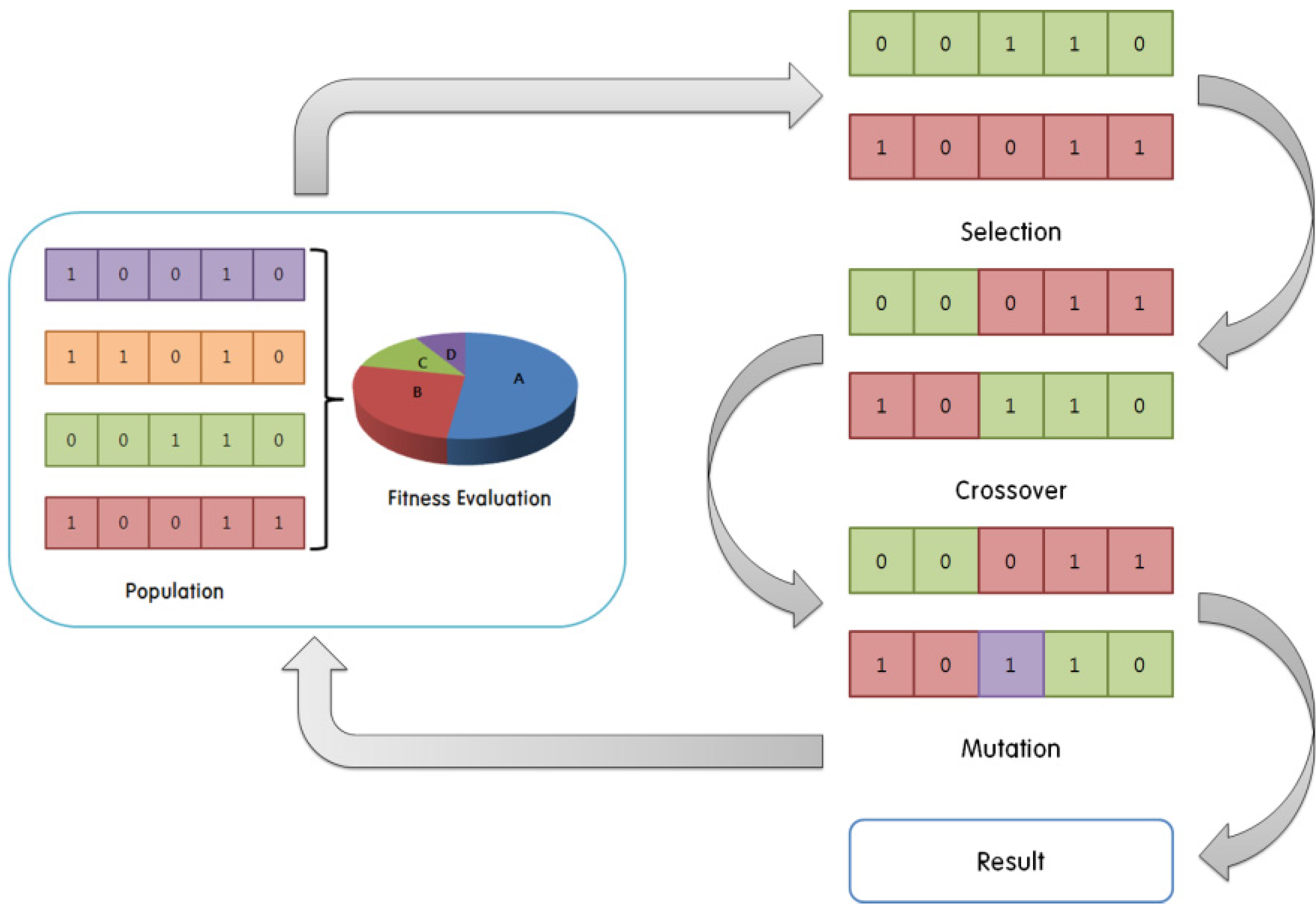

2.2. Characteristics of Non-Point Source Pollution Loads with Classifications of Various Land Use and Rainfall Criteria
| Rainfall ranges | Korean ministry of environment—event mean concentration (mg/L) | |||||||||||
|---|---|---|---|---|---|---|---|---|---|---|---|---|
| Below 10 mm | 10–30 mm | 30–50 mm | Over 50 mm | |||||||||
| water quality items | BOD | TN | TP | BOD | TN | TP | BOD | TN | TP | BOD | TN | TP |
| Residential | 6.1 | 7.1 | 0.2 | 7.3 | 7.0 | 0.2 | 7.0 | 2.7 | 0.2 | 2.8 | 6.4 | 0.4 |
| Industrial | 53.7 | 8.3 | 1.2 | 29.7 | 4.1 | 0.6 | 12.0 | 4.4 | 0.1 | 3.9 | 2.0 | 0.1 |
| Commercial | 16.8 | 2.8 | 1.3 | 21.1 | 3.1 | 0.5 | 20.4 | 2.1 | 1.3 | 9.8 | 1.5 | 1.4 |
| Leisure | 24.2 | 5.4 | 1.8 | 64.8 | 2.9 | 0.7 | 19.9 | 4.7 | 0.5 | 16.1 | 4.6 | 0.7 |
| Transportation | 12.3 | 3.0 | 1.3 | 6.8 | 2.6 | 0.2 | 5.5 | 2.2 | 0.2 | 2.3 | 1.1 | 0.1 |
| Public building | 7.9 | 7.3 | 0.3 | 9.0 | 5.9 | 0.3 | 4.8 | 1.6 | 0.1 | 4.7 | 6.7 | 0.7 |
| Paddy | 4.0 | 2.2 | 0.2 | 3.9 | 2.5 | 0.6 | 3.9 | 3.1 | 0.3 | 3.7 | 2.7 | 0.4 |
| Upland | 0.0 | 0.0 | 0.0 | 16.9 | 2.4 | 2.4 | 13.6 | 5.4 | 2.3 | 40.7 | 8.6 | 10.3 |
| Green house | 7.8 | 2.2 | 0.6 | 11.8 | 4.5 | 1.7 | 11.0 | 5.5 | 3.2 | 12.4 | 4.5 | 2.1 |
| Orchard | 0.0 | 0.0 | 0.0 | 1.0 | 0.4 | 0.1 | 3.7 | 1.5 | 0.2 | 2.5 | 2.0 | 0.4 |
| Other Crop | 0.0 | 0.0 | 0.0 | 0.0 | 0.0 | 0.0 | 4.4 | 10.1 | 1.3 | 2.0 | 5.7 | 1.4 |
| Deciduous forest | 1.2 | 1.7 | 0.1 | 1.2 | 2.0 | 0.1 | 1.8 | 3.3 | 0.2 | 2.1 | 1.8 | 0.5 |
| Coniferous forest | 1.1 | 1.8 | 0.1 | 1.1 | 1.9 | 0.0 | 1.2 | 2.4 | 0.0 | 0.9 | 1.7 | 0.0 |
| Mixed forest | 1.2 | 1.8 | 0.1 | 1.8 | 0.6 | 0.0 | 1.8 | 1.6 | 0.1 | 0.9 | 1.8 | 0.0 |
| Golf course | 4.6 | 7.1 | 1.5 | 6.1 | 4.8 | 1.3 | 6.2 | 6.9 | 1.9 | 3.9 | 4.9 | 1.5 |
| Pasture | 3.6 | 2.0 | 0.5 | 6.8 | 2.6 | 0.6 | 3.9 | 2.4 | 0.3 | 3.4 | 2.0 | 0.7 |
| Grass | 3.6 | 2.0 | 0.5 | 6.8 | 2.6 | 0.6 | 3.9 | 2.4 | 0.3 | 3.4 | 2.0 | 0.7 |
| Mining area | 15.6 | 5.5 | 0.2 | 12.4 | 2.6 | 0.9 | 19.8 | 2.3 | 0.7 | 13.3 | 2.2 | 0.7 |
| Barren | 15.6 | 5.5 | 0.2 | 12.4 | 2.6 | 0.9 | 19.8 | 2.3 | 0.7 | 13.3 | 2.2 | 0.7 |
| Inland wetland | – | – | – | – | – | – | – | – | – | – | – | – |
| Costal wetland | – | – | – | – | – | – | – | – | – | – | – | – |
| Water | – | – | – | – | – | – | – | – | – | – | – | – |
| Sea | – | – | – | – | – | – | – | – | – | – | – | – |
2.3. Application of L-THIA 2012
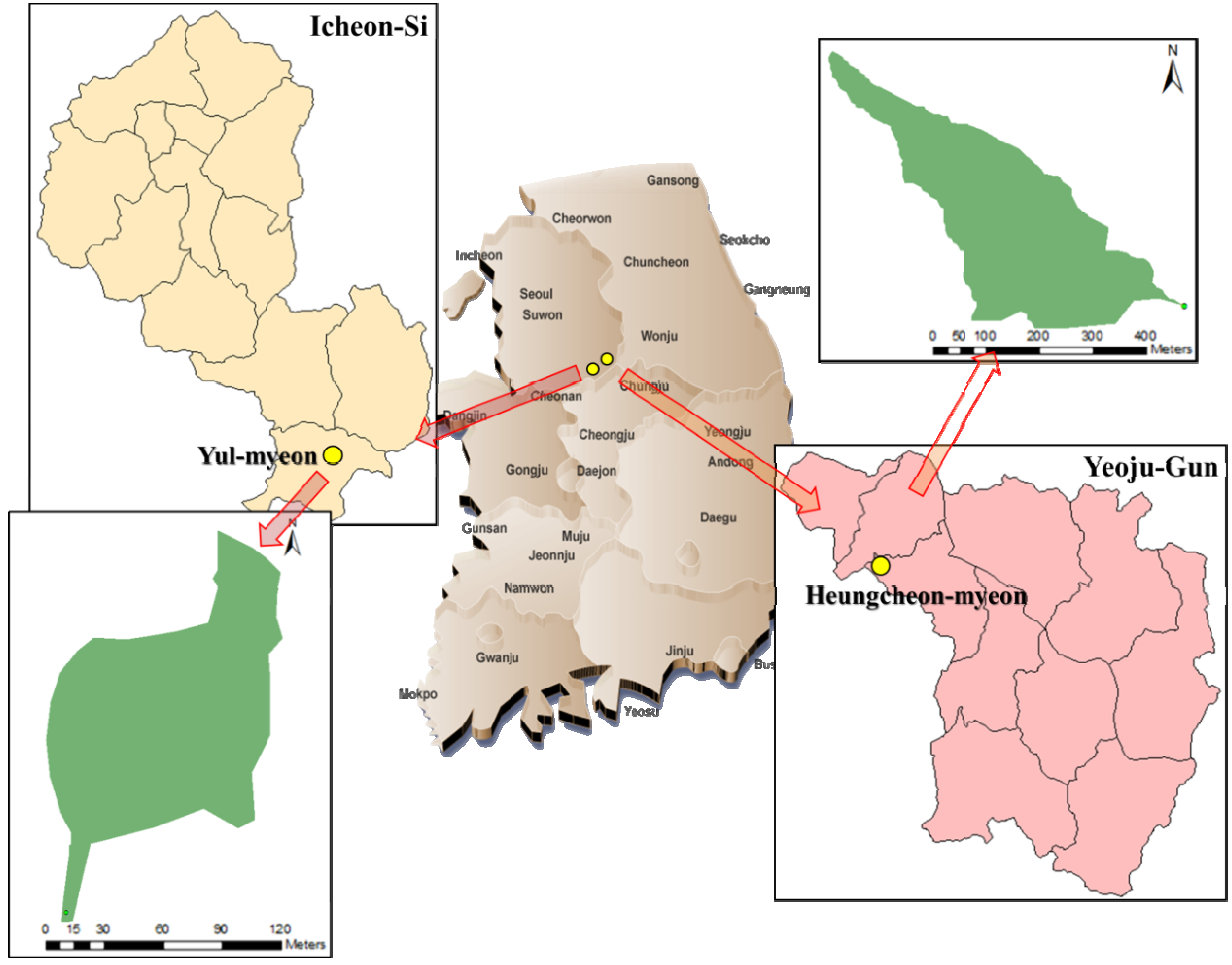
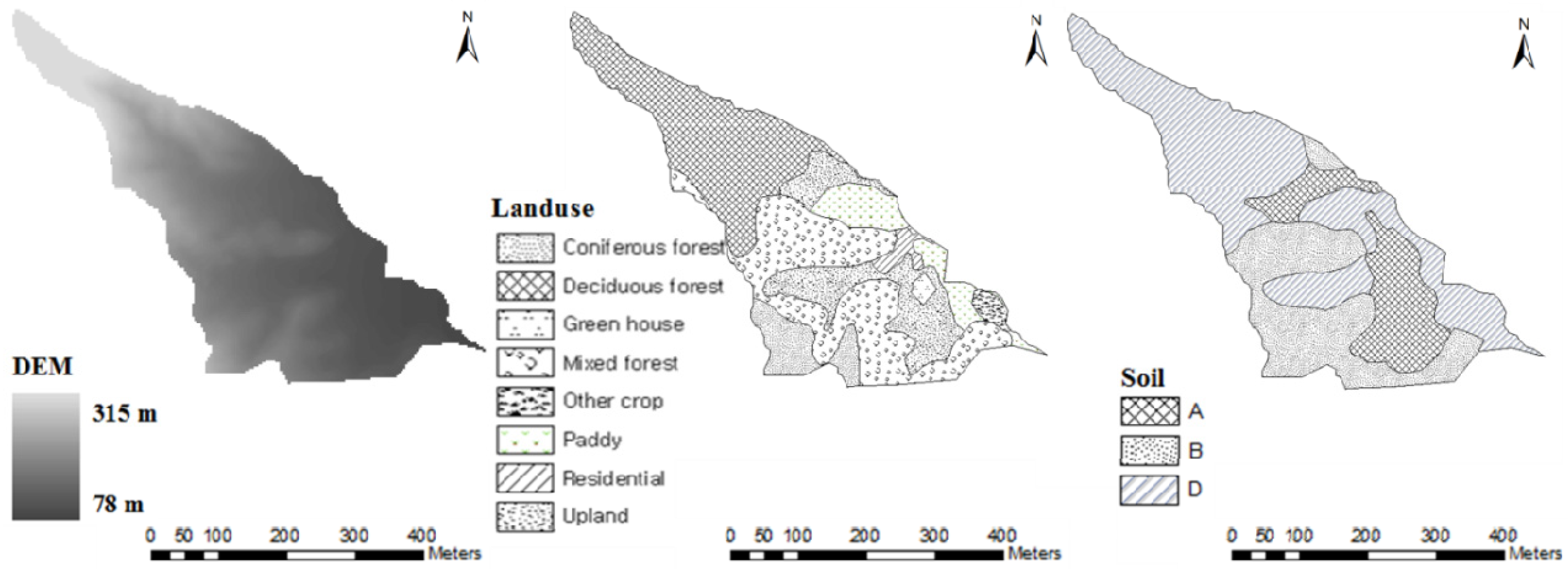
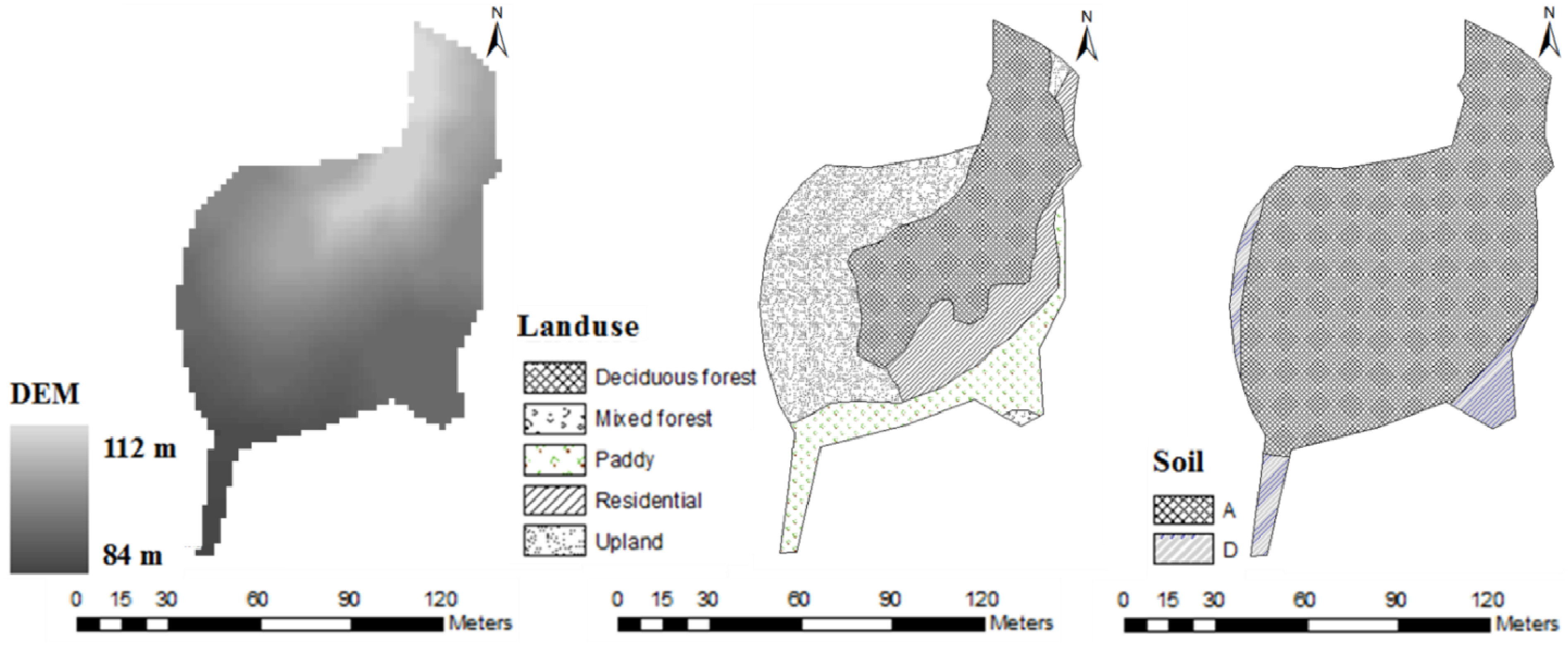
| Yeoju-Gun | Icheon-Si | ||
|---|---|---|---|
| Date | Rainfall (mm) | Date | Rainfall (mm) |
| 22 April 2011 | 30.5 | 8 July 2011 | 104.5 |
| 30 April 2011 | 80.5 | 8 August 2011 | 50.0 |
| 23 June 2011 | 31.2 | 13 August 2011 | 67.0 |
| 13 August 2011 | 48.8 | 11 September 2011 | 124.5 |
| 29 September 2011 | 23.4 | 29 September 2011 | 28.5 |
| 6 November 2011 | 15.8 | 15 October 2011 | 60.0 |
3. Results and Discussion
3.1. Development of L-THIA 2012 Model
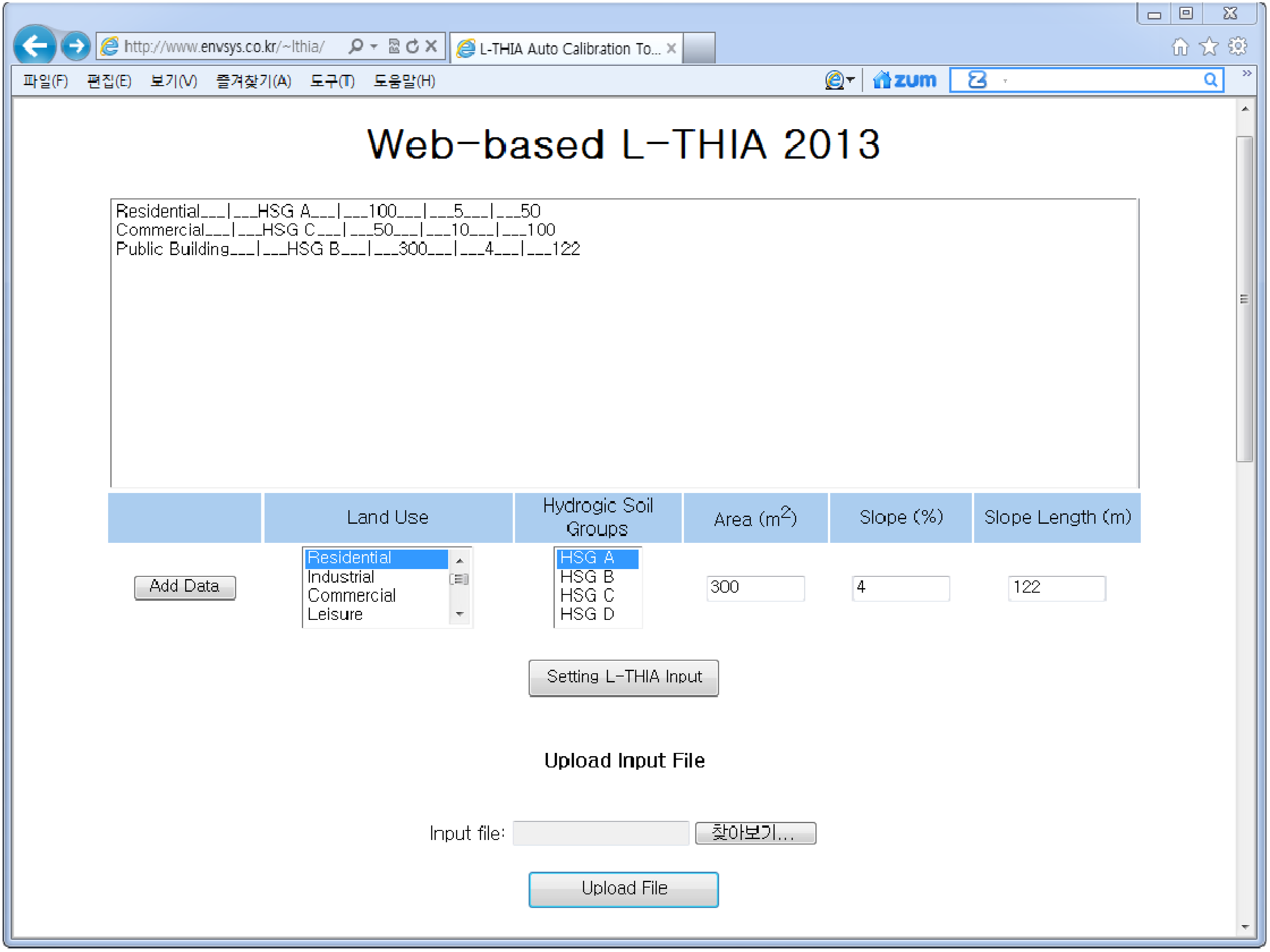

3.2. Runoff and NPS Pollutant Load Estimations
| Study area | Date | Measured data | Estimated data | ||||||
|---|---|---|---|---|---|---|---|---|---|
| Direct runoff (m3) | BOD (m3) | TN (kg) | TP (kg) | Direct runoff (m3) | BOD (m3) | TN (kg) | TP (kg) | ||
| Yeoju-Gun | 22 April 2011 | 972.74 | 5.94 | 5.83 | 0.82 | 840.95 | 4.70 | 3.36 | 0.59 |
| 30 April 2011 | 3669.41 | 53.45 | 23.99 | 6.32 | 4725.77 | 39.71 | 17.43 | 6.36 | |
| 23 June 2011 | 482.05 | 12.80 | 4.24 | 0.89 | 829.81 | 4.59 | 3.30 | 0.58 | |
| 13 August 2011 | 2338.54 | 27.31 | 4.13 | 1.87 | 1795.21 | 9.90 | 7.39 | 1.28 | |
| 29 September 2011 | 599.47 | 1.70 | 1.85 | 0.12 | 600.51 | 3.30 | 1.93 | 0.49 | |
| 6 November 2011 | 728.10 | 10.44 | 4.01 | 0.55 | 371.23 | 1.96 | 1.17 | 0.29 | |
| Icheon-Si | 8 July 2011 | 2635.47 | 20.28 | 14.22 | 4.75 | 2034.23 | 32.77 | 14.41 | – |
| 8 August 2011 | 272.99 | 1.95 | 2.01 | 0.08 | 510.22 | 7.68 | 3.42 | – | |
| 13 August 2011 | 862.76 | 1.50 | 2.43 | 0.23 | 898.05 | 14.26 | 6.29 | – | |
| 11 September 2011 | 3530.69 | 36.86 | 31.29 | 4.13 | 2707.61 | 42.95 | 18.97 | – | |
| 29 September 2011 | 249.15 | 1.32 | 1.37 | 0.11 | 152.39 | 1.02 | 0.50 | – | |
| 15 October 2011 | 247.74 | 7.40 | 2.91 | 0.61 | 727.48 | 11.36 | 5.02 | – | |
3.3. Comparison of the Calibrated and Averaged EMCs
| Study Area | Date | Measured data | Estimated data (using averaged EMCs) | ||||||
|---|---|---|---|---|---|---|---|---|---|
| Direct runoff (m3) | BOD (m3) | TN (kg) | TP (kg) | Direct runoff (m3) | BOD (m3) | TN (kg) | TP (kg) | ||
| Yeoju-Gun | 22 April 2011 | 972.74 | 5.94 | 5.83 | 0.82 | 972.74 | 8.98 | 3.30 | 0.77 |
| 30 April 2011 | 3669.41 | 53.45 | 23.99 | 6.32 | 3669.41 | 33.89 | 12.44 | 2.91 | |
| 23 June 2011 | 482.05 | 12.80 | 4.24 | 0.89 | 482.05 | 4.45 | 1.63 | 0.38 | |
| 13 August 2011 | 2338.54 | 27.31 | 4.13 | 1.87 | 2338.54 | 21.60 | 7.93 | 1.85 | |
| 29 September 2011 | 599.47 | 1.70 | 1.85 | 0.12 | 599.47 | 5.54 | 2.03 | 0.48 | |
| 6 November 2011 | 728.10 | 10.44 | 4.01 | 0.55 | 728.10 | 6.73 | 2.47 | 0.58 | |
| Icheon-Si | 8 July 2011 | 2635.47 | 20.28 | 14.22 | 4.75 | 2635.47 | 24.34 | 8.93 | – |
| 8 August 2011 | 272.99 | 1.95 | 2.01 | 0.08 | 272.99 | 2.52 | 0.93 | – | |
| 13 August 2011 | 862.76 | 1.50 | 2.43 | 0.23 | 862.76 | 7.97 | 2.92 | – | |
| 11 September 2011 | 3530.69 | 36.86 | 31.29 | 4.13 | 3530.69 | 32.61 | 11.97 | – | |
| 29 September 2011 | 249.15 | 1.32 | 1.37 | 0.11 | 249.15 | 2.30 | 0.84 | – | |
| 15 October 2011 | 247.74 | 7.40 | 2.91 | 0.61 | 247.74 | 2.29 | 0.84 | – | |
4. Conclusions
Conflicts of Interest
References
- Choi, J.Y. Status and prospects of nonpoint source management policies, water for future. J. Korea Water Res. Assoc. 2006, 39, 12–18. [Google Scholar]
- Gyeonggi Research Institute (GRI). Policy study on the application of estimation techniques nonpoint source pollution. Gyeonggi Res. Inst. 2008, 25–60. [Google Scholar]
- Ministry of Environment. Establishment of Comprehensive Measures for Control of Non-Point Source Pollutant Loads of the Four Major River Basins; Ministry of Environment: Seoul, Korea, 2004.
- Rewerts, C.C.; Engel, B.A. ANSWERS on GRASS: Integrating a watershed simulation with a GIS. Trans. ASABE 1991, 91-2621, 1–9. [Google Scholar]
- Young, R.A.; Onstad, C.A.; Bosch, D.; Anderson, W.P. AGNPS, Agricultural Non-point Source Pollution Model: A Watershed Analysis Tool, USDA; Conservation Research Report 35; U.S. Department of Agriculture, Agricultural Research Service: Washington, DC, USA, 1987; pp. 49–51.
- Arnold, J.G.; Srinivasan, R.; Muttiah, R.S.; Williams, J.R. Large area hydrologic modeling and assessment part I: Model development. J. Am. Water Res. Assoc. 1998, 34, 73–89. [Google Scholar] [CrossRef]
- Bicknell, B.R.; Imhoff, J.I., Jr.; Jobes, T.H.; Donigian, A.S., Jr. Hydrologic Simulation Program Fortran (HSPF) User’s Manual for Version 12; U.S. Environmental Protection Agency, National Exposure Research Laboratory: Athens, Greece, 2001; pp. 1–12.
- Huber, W.C.; Dickinson, R.E. Storm Water Management Model Version 4; User’s Manual; University of Florida, Department of Environmental Engineering Sciences: Gainesville, FL, USA, 1988; pp. 1–15. [Google Scholar]
- Harbor, J.M. A practical method for estimating the impact of land-use change on surface runoff, groundwater recharge and wetland hydrology. J. Am. Plan. Assoc. 1994, 60, 95–108. [Google Scholar] [CrossRef]
- Bhaduri, B.; Minner, M.; Tatalovich, S.; Harbor, J. Assessing the long-term hydrological impact of land-use change: Cuppy-mcclue watershed, Indiana. J. Am. Water Works Assoc. 1997, 89, 13–19. [Google Scholar]
- Miner, M.; Harbor, J.; Happold, S.; Michael-Butler, P. Cost apportionment for a storm water management system: Differential burdens on landowners from hydrologic and area-based approaches. Appl. Geogr. Stud. 1998, 14, 1–14. [Google Scholar]
- Lim, K.J.; Engel, B.A. Development of Daily/Yearly L-THIA WWW System. Available online: https://engineering.purdue.edu/mapserve/LTHIA7 (accessed on 20 November 2013).
- Lim, K.J.; Engel, B.A.; Kim, Y.; Bhaduri, B.; Harbor, J. Development of the Long-Term Hydrologic Impact Assessment (L-THIA) WWW System. In Proceedings of the 10th International Soil Conservation, 2 May 2002; Stott, D., Mohtar, R., Steinhardt, G., Eds.; Purdue University: West Lafayette, IN, USA; pp. 1018–1023.
- Lim, K.J.; Engel, B.A.; Tang, Z.; Muthukrishnan, S.; Choi, J.; Kim, K. Effect of calibration on L-THIA GIS runoff and pollutant estimation. J. Environ. 2006, 78, 35–43. [Google Scholar]
- Kim, J.J.; Kim, T.D.; Choi, D.H.; Lim, K.J.; Engel, B.A.; Jeon, J.H. L-THIA modification and SCE-UA application for spatial analysis of nonpoint source pollution at Gumho river basin. J. Korea Water Res. Assoc. 2009, 25, 311–321. [Google Scholar]
- Beven, K.; Binley, A. The future of distributed models: Model calibration and uncertainty predictions. Hydrol. Process. 1992, 6, 279–298. [Google Scholar] [CrossRef]
- Beven, K.; Freer, J. Equifinality, data assimilation, and uncertainty estimation in mechanistic modelling of complex environmental systems using the GLUE methodology. J. Hydrol. 2001, 249, 11–29. [Google Scholar] [CrossRef]
- Holland, J.H. Adaptation in Natural and Artificial System; University of Michigan Press: Ann Arbor, MI, USA, 1975. [Google Scholar]
- Wang, Q.J. The genetic algorithm and its application to calibrating conceptual rainfall-runoff models. Water Resour. Res. 1991, 27, 2467–2471. [Google Scholar] [CrossRef]
- Lim, K.J.; Park, Y.S.; Kim, J.; Sin, Y.; Kim, N.W.; Kim, S.J.; Jeon, J.; Engel, B.A. Development of genetic algorithm-based optimization Module in WHAT system for hydrograph analysis and model application. Comput. Geosci. 2010, 36, 936–944. [Google Scholar] [CrossRef]
- Shin, Y.; Mohanty, B.P.; Ines, A.V.M. Soil hydraulic properties in one-dimensional layered soil profile using layer-specific soil moisture assimilation scheme. Water Resour. Res. 2012, 48. [Google Scholar] [CrossRef]
- Duan, Q.Y.; Sorooshian, S.; Gupta, H.V. Effective and efficient global optimization for conceptual rainfall-runoff models. Water Resour. Res. 1992, 28, 1015–1031. [Google Scholar] [CrossRef]
- Kum, D.H.; Ryu, J.C.; Choi, J.W.; Shin, M.H.; Shin, D.S.; Cheon, S.U.; Choi, J.D.; Lim, K.J. Development and evaluation of runoff-sediment evaluation system and BMPs evaluation modules for agricultural fields using hourly rainfall. J. Korea Water Res. Assoc. 2012, 28, 375–383. [Google Scholar]
- Goldberg, D.E. Genetic Algorithms in Search and Optimization and Machine Learning; Addison-Wesley Longman Publishing Co., Inc.: Boston, MA, USA, 1989. [Google Scholar]
- Krishnakumar, K. Microgenetic algorithms for stationary and non-stationary function optimization. Proc. SPIE Intell. Control Adapt. Syst. 1989, 1196, 289–296. [Google Scholar] [CrossRef]
- Carroll, D.L. Genetic algorithms and optimizing chemical oxygen-Iodine lasers. Dev. Theor. Appl. Mech. 1996, 18, 411–424. [Google Scholar]
- Ines, A.V.M.; Droogers, P. Inverse modeling in estimating soil hydraulic functions: A genetic algorithm approach. Hydrol. Earth Syst. Sci. 2002, 6, 49–65. [Google Scholar] [CrossRef]
- Ines, A.V.M.; Mohanty, B.P. Near-surface soil moisture assimilation for quantifying effective soil hydraulic properties using genetic algorithm: 1. Conceptual modeling. Water Resour. Res. 2008, 44. [Google Scholar] [CrossRef]
- Shin, Y.; Mohanty, B.P. Development of a deterministic downscaling algorithm for remote sensing soil moisture footprint using soil and vegetation classifications. Water Resour. Res. 2013, 49. [Google Scholar] [CrossRef]
- Hanriver Environment Research Center. Long-Term Monitoring of Nonpoint Source Pollution from Major Land Uses (6); Hanriver Environment Research Center: Seoul, Korea, 2012.
- Geumriver Environment Research Center. Long-Term Monitoring of Nonpoint Source Pollution from Major Land Uses (3); Geumriver Environment Research Center: Seoul, Korea, 2009.
- Hanriver Environment Research Center. Long-Term Monitoring of Nonpoint Source Pollution from Major Land Uses (3); Hanriver Environment Research Center: Seoul, Korea, 2009.
- Nakdongriver Environment Research Center. Long-Term Monitoring of Nonpoint Source Pollution from Major Land Uses (3); Nakdongriver Environment Research Center: Seoul, Korea, 2009.
- Yeongsanriver Environment Research Center. Long-Term Monitoring of Nonpoint Source Pollution from Major Land Uses (3); Yeongsanriver Environment Research Center: Seoul, Korea, 2009.
- United States Department of Agriculture, Soil Conservation Service (USDA-SCS). National Engineering Handbook, Section 4—Hydrology; USDA: Washington, DC, USA, 1985.
- Natural Resources Conservation Service (NRCS). Urban Hydrology for Small Watersheds; Technical Release 55; NRCS: Washington, DC, USA, 1986.
- Ministry of Construction Transportation (MOCT). River Design Criteria Description; MOCT: Seoul, Korea, 2005.
- Donigian, A.S. HSPF Training Workshop Handbook and CD, Lecture #19, Calibration and Verification Issues, Slide #L19-22 [DCN 1-0238]; Environmental Protection Agency: Washington, DC, USA, 2000.
© 2013 by the authors; licensee MDPI, Basel, Switzerland. This article is an open access article distributed under the terms and conditions of the Creative Commons Attribution license (http://creativecommons.org/licenses/by/3.0/).
Share and Cite
Jang, C.; Kum, D.; Jung, Y.; Kim, K.; Shin, D.S.; Engel, B.A.; Shin, Y.; Lim, K.J. Development of a Web-Based L-THIA 2012 Direct Runoff and Pollutant Auto-Calibration Module Using a Genetic Algorithm. Water 2013, 5, 1952-1966. https://doi.org/10.3390/w5041952
Jang C, Kum D, Jung Y, Kim K, Shin DS, Engel BA, Shin Y, Lim KJ. Development of a Web-Based L-THIA 2012 Direct Runoff and Pollutant Auto-Calibration Module Using a Genetic Algorithm. Water. 2013; 5(4):1952-1966. https://doi.org/10.3390/w5041952
Chicago/Turabian StyleJang, Chunhwa, Donghyuk Kum, Younghun Jung, Kyoungsoon Kim, Dong Suk Shin, Bernard A. Engel, Yongchul Shin, and Kyoung Jae Lim. 2013. "Development of a Web-Based L-THIA 2012 Direct Runoff and Pollutant Auto-Calibration Module Using a Genetic Algorithm" Water 5, no. 4: 1952-1966. https://doi.org/10.3390/w5041952




